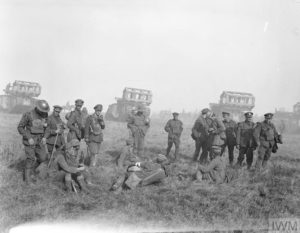Thursday October 3rd, 1918
Off again. Unknown town.
Tank Warfare
Today the Battalion is practicing an attack – assisted by phantom tanks that are represented by flags.

As noted in earlier posts, by 1918, tanks had started to establish their role in modern warfare. This was cemented during the Hundred Day Offensive. As Burgon Bickersteth, a Cavalry officer working in Intelligence at the Battle of Amiens, wrote: ‘The attack went well from the first. Zero was at 4:20am on Thursday [August 8th, 1918]. A few hours later the whole countryside was covered with advancing troops. Tanks by the score were snorting along by the side of the cavalry.’¹
The photograph shows men and tanks at the Battle of St Quentin Canal (Saint-Quentin). Prisoners with American escort (30th Division) resting in the foreground. In the background, four 8th Battalion, Tank Corps, Mark V Tanks with ‘cribs’ on their roofs. These were attached to the 5th Australian Division, Fourth Army Front, near Bellicourt, 29th September 1918.* The ‘cribs’ or fascines were carried to fill in trenches that otherwise would be an obstacle to the tanks.³
Infantry & Tanks
The successful collaboration of tanks and infantry was actually a mutually beneficial arrangement. This was made clear when, during the assault over Bellicourt Tunnel (part of the Battle of St Quentin), some British tanks became isolated:
‘In one instance four heavy tanks and five medium tanks were destroyed in the space of 15 minutes by German field guns …. This was during the attempt to subdue severe machine gun fire coming from the Le Catelet–Nauroy Line in the vicinity of Cabaret Wood Farm … and showed the danger posed by German field guns to tanks operating without close infantry support (because the crew had very limited visibility and often could not see a threat which those outside the tank could see). The tanks could protect the infantry but they also needed the close cooperation of the infantry to alert them to the danger of concealed field guns. In the case of this attack, the machine gun fire was so severe that the infantry were ordered to withdraw, leaving the tanks well forward of them and prey to the German field guns.‘²
Let’s hope the Battalion’s practice went well.
9th Battalion War Diary – 3rd October 1918 – Maricourt
Battalion practiced an attack in open warfare assisted by tanks represented by flags. Operation Order No 6 (Appendix No 1) issued at 21:15hrs.
References & Further Reading
¹ ‘The Bickersteth Diaries 1914-1918’, edited by John Bickersteth, 1995, Leo Cooper, page 267
² ‘Battle of St Quentin‘ on Wikipedia
³ Fascine on Wikipedia
* Q 9246, copyright Imperial War Museums


